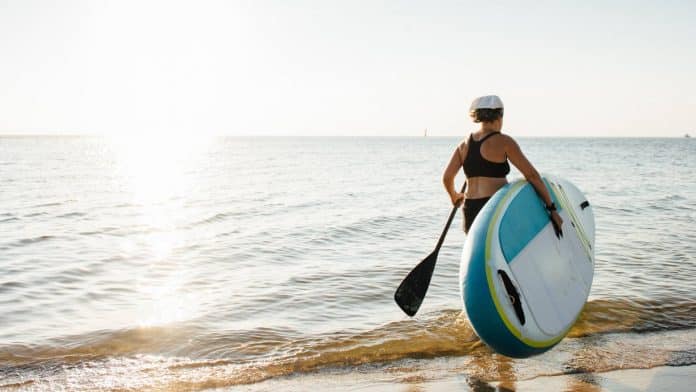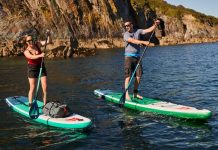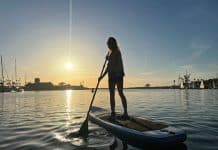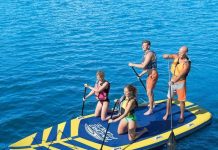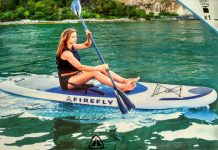Choose the Right Board
Consider the size and weight of the board
When choosing a stand-up paddleboard, it’s essential to consider the size and weight of the board. A giant board will provide more stability and be easier to balance, making it an excellent choice for beginners.
However, a giant board may also be heavier and more challenging to maneuver. On the other hand, a smaller board will be easier to handle and maneuver but may not provide the same level of stability.
Finding a board with the right size and weight for your skill level and intended use is essential. Consider renting or borrowing different boards before purchasing to find the perfect fit.
Think about the type of water you’ll be paddling in.
Before you hit the water, it’s essential to consider the type of environment you’ll be paddling in. Calm lakes and slow-moving rivers are great for beginners, as they offer a stable surface and minimal currents.
However, if you plan to paddle in the ocean or a fast-moving river, you must be prepared for more challenging conditions.
Ensure you have the appropriate gear, such as a leash and a personal flotation device, and consider taking a lesson or paddling with a more experienced friend. Always check the weather and water conditions before heading out; never paddle in conditions beyond your skill level.
Choose a board with a stable shape.
When choosing a stand-up paddle board, it’s essential to consider the shape of the board. A stable shape is crucial for beginners, providing a solid foundation for balance and control.
Look for boards with a broader and thicker shape, as they tend to be more stable. Additionally, boards with a rounded nose and tail can help with stability and maneuverability.
It’s also important to consider the board’s weight capacity, as a board that is too small for your weight can make it challenging to balance. Take the time to research and test out different board shapes to find the one that best suits your needs and skill level.
Get the Right Gear
Invest in a good-quality paddle.
Investing in a good paddle is crucial for a comfortable and efficient stand-up paddleboarding experience. A high-quality paddle will not only help you navigate through the water with ease but also reduce the risk of injury and fatigue.
Look for a lightweight, durable, and adjustable paddle to your height and paddling style. Carbon fiber and fiberglass paddles are popular among experienced paddleboarders due to their strength and lightweight design.
While a good quality paddle may come with a higher price tag, it is a worthwhile investment to enhance your overall paddleboarding experience.
Wear a personal flotation device.
Wearing a personal flotation device (PFD) is crucial for all stand-up paddle boarders, especially beginners.
A PFD can save your life in an unexpected fall or accident. Choosing a PFD that fits you properly and is comfortable to wear is essential. Make sure to wear it at all times while on the water, even if you are a strong swimmer.
Attaching a whistle to your PFD in case you need to signal for help is also a good idea. Remember, safety should always be your top priority when paddle boarding.
Wear appropriate clothing and footwear.
Regarding stand-up paddle boarding, it’s essential to wear appropriate clothing and footwear. You’ll want to wear comfortable clothing for a full range of motion.
Quick-drying materials are also suitable, as you’ll likely get wet during your paddle. As for footwear, it’s best to wear water shoes or sandals with an excellent grip to prevent slipping on your board.
Avoid wearing flip-flops or shoes that could easily fall off and get lost in the water. You’ll thoroughly enjoy your paddle without discomfort or safety concerns by wearing the proper clothing and footwear.
Learn the Proper Technique
Start on your knees
Starting on your knees is a great way to get comfortable with the board and the paddle before standing up.
Begin by kneeling in the center of the board with your toes curled under your feet. Keep your hands on either side of the board and your core engaged. From there, practice paddling forward and turning the board.
Once you feel confident and stable, you can slowly stand up and continue paddling. Remember to keep your knees slightly bent and your weight evenly distributed on the board.
Starting on your knees is a great way to build your confidence and get a feel for the board before taking on more challenging conditions.
Use your core muscles to paddle.
Using your core muscles to paddle is essential for maintaining balance and stability on your stand-up paddleboard.
Your core muscles, including your abs, obliques, and lower back, keep your body upright and centered on the board. To engage your core muscles while paddling, focus on rotating your torso with each stroke rather than just using your arms.
This will improve your balance and make your paddling more efficient and less tiring. Remember to keep your core engaged throughout your entire paddle session, even when not actively paddling.
This will help you maintain good posture and prevent fatigue and discomfort in your back and shoulders.
Keep your eyes on the horizon.
Keeping your eyes on the horizon is crucial when stand-up paddle boarding. It helps you maintain your balance and stay on course.
By focusing on a fixed point in the distance, you can avoid getting distracted by the movement of the water or the people around you. Additionally, looking ahead allows you to anticipate any changes in the water conditions or obstacles in your path.
So, whether you’re paddling on a calm lake or in the ocean, always remember to keep your eyes on the horizon and stay focused on your goal.
Practice Balancing
Start in calm water
Starting in calm water is crucial for beginner stand-up paddle boarders. It lets you get comfortable with the board and your balance without the added challenge of waves or currents. Look for a calm bay or lake with little to no wind.
Safety should always be your top priority. Once you feel confident in calm water, you can gradually move to more challenging conditions. Always wear a leash and a personal flotation device, even in calm water.
Practice shifting your weight.
One of the most essential skills to master as a beginner stand-up paddleboarder is shifting your weight.
This involves moving your body weight forward or backward on the board to maintain balance and control. Stand in the middle of the board to practice this skill with your feet shoulder-width apart.
Slowly shift your weight forward and back, feeling the board respond to your movements. As you become more comfortable, try shifting your weight from side to side to turn the board.
With practice, you’ll develop the muscle memory and balance needed to confidently navigate the water on your stand-up paddle board.
Try different foot positions.
Trying different foot positions on your stand-up paddle board can help you find the most comfortable and stable stance for your body. Start by placing your feet shoulder-width apart and parallel to the board.
Remember to keep your knees slightly bent and your weight centered over the board for the best balance. As you gain confidence, experiment with a narrower or staggered stance with one foot slightly in front of the other.
You can also try moving your feet closer to the board’s rails for more stability in choppy water. With practice, you’ll find the foot position that works best for you and your paddling style.
Be Aware of Your Surroundings
Watch out for other watercraft.
When you’re out on the water, you must be aware of your surroundings and watch for other watercraft. This includes boats, jet skis, kayaks, and other paddle boarders.
Safety should always be your top priority when out on the water. Always give them plenty of space and avoid crossing in front of them. If you’re paddling in a busy area, it’s a good idea to wear a brightly colored rash guard or life jacket to make yourself more visible.
Be aware of changing weather conditions.
Wind, rain, and thunderstorms can all impact your paddle-boarding experience and safety. As a beginner stand-up paddle boarder, it’s essential to be aware of changing weather conditions.
Before heading out on the water, check the weather forecast and be prepared for any changes.
If you notice the weather changing while you’re on the water, head back to shore immediately. It’s better to be safe than sorry, so always be cautious about weather conditions.
Stay away from areas with strong currents or waves.
Remember, safety should always be your top priority when paddle boarding—being aware of your surroundings when paddle boarding is essential, especially regarding currents and waves.
Strong currents can quickly carry you away from your intended destination, and waves can make maintaining your balance on the board difficult.
If you’re a beginner, avoiding areas with strong currents or waves is best until you feel more comfortable and confident on the board. Stick to calm, flat waters and gradually work to more challenging conditions as you gain experience.
Start Slow
Don’t try to do too much too soon.
It’s important to remember that stand-up paddle boarding takes time and practice to master. Don’t try to do too much too soon, as this can lead to frustration and even injury.
Start with the basics, such as learning how to balance on the board and paddle properly. Once you feel comfortable with these skills, gradually increase the difficulty level by trying new techniques and exploring different types of water.
Remember, the goal is to have fun and enjoy the experience, so take your time and don’t rush the learning process.
Take breaks when you need to
Listening to your body when you’re out on the water is essential. If you’re tired or weary, take a break and rest briefly. This will help prevent injury and ensure you can enjoy your paddleboarding experience.
You can take a break by sitting or lying on your board, paddling to shore, and taking a break on land. Don’t push yourself too hard, especially if you’re new to the sport.
Remember, paddleboarding is supposed to be fun and relaxing, so take breaks when you need to and enjoy the scenery around you.
Gradually increase your distance and speed.
As you become more comfortable on your stand-up paddle board, gradually increasing your distance and speed is essential. Start paddling for short distances at a slower pace, then gradually increase the distance and speed as you feel more confident.
It’s essential to listen to your body and not push yourself too hard too quickly. Remember to take breaks and hydrate regularly, especially on longer paddles.
By gradually increasing your distance and speed, you’ll build endurance and improve your overall paddling skills.
Learn to Fall Safely
Try to fall away from your board.
While falling off your paddle board may seem scary, it’s important to remember that it will happen at some point. Try to fall away from your board rather than onto it when it does.
Falling onto your board can result in injury while falling away from it results in a refreshing dip in the water. Additionally, falling away from your board will prevent you from damaging it or your paddle.
So, when you feel yourself losing balance, aim for the water rather than your board. You’ll become more comfortable and confident on your board with practice, and falling will become less frequent.
Cover your head with your arms.
Covering your head with your arms is a crucial safety measure every beginner stand-up paddle boarder should know. If you fall off the board, covering your head with your arms can protect you from hitting rocks or other objects in the water.
It’s essential to keep your arms close to your head and hold onto your paddle to prevent it from hitting you or someone else.
Always wear a properly fitted and secured life jacket for added safety. By taking these precautions, you can enjoy your paddle boarding experience with peace of mind.
Retrieve your board before your paddle.
It’s important to remember that your paddle is useless without your board. Before you paddle, ensure your board is securely attached to your leash and within reach.
If you fall off your board, always retrieve it before going after your paddle.
This will prevent your board from drifting away and potentially causing harm to other water users. Swimming with your paddle is much easier than with a large board, so prioritize retrieving your board first.
Explore Different Waterways
Try different bodies of water.
Trying different bodies of water can be a great way to challenge yourself and improve your stand-up paddleboarder skills.
Calm lakes and ponds are ideal for beginners, but as you become more comfortable on the board, you may want to try paddling in rivers or the ocean. Each body of water presents unique challenges, such as currents, waves, and wind, which can help you develop your balance and technique.
Just research the conditions and safety precautions before venturing into unfamiliar waters. And don’t forget to bring a friend or paddle with a group for added safety.
Explore different routes and distances.
Once you have mastered the basics of stand-up paddle boarding, it’s time to explore different routes and distances.
Start by paddling around your local lake or river, gradually increasing the distance you cover. This can be a great way to challenge yourself and improve your skills. You can also try paddling in different conditions, such as calm water or choppy waves.
Don’t be afraid to venture out of your comfort zone and try new things – make sure you stay safe and always wear a life jacket. With some practice, you’ll soon be able to paddle longer distances and tackle more challenging routes.
Enjoy the scenery
One of the best things about stand-up paddle boarding is the opportunity to enjoy the beautiful scenery. Take a moment to look around and appreciate the natural beauty of your surroundings.
You may even spot some wildlife, such as birds or fish, as you glide along the water. Don’t forget to bring a camera or phone to capture some fantastic photos of your adventure.
Remember to stay aware of your surroundings and avoid distractions that could lead to accidents. Enjoying the scenery is a great way to relax and unwind while getting a workout at the same time.
Join a Group or Take a Lesson
Meet other paddle boarders.
Meeting other paddle boarders can be a great way to learn more about the sport and improve your skills.
Don’t be afraid to converse with other paddle boarders you encounter on the water – you may even make some new friends! Look for local paddle board groups or clubs in your area, or join online communities and forums to connect with other enthusiasts.
Attending paddle board events or races can also be fun to meet other paddlers and learn from their experiences.
Learn from experienced instructors.
Learning from experienced instructors is crucial for beginner stand-up paddle boarders. They can teach you the proper techniques and safety measures and help you build confidence on the board.
Instructors can also provide valuable feedback on your form and help you improve your skills. It’s essential to find a reputable instructor who is certified and has experience teaching beginners.
Don’t hesitate to ask questions and communicate your concerns with your instructor. With their guidance, you’ll be able to progress quickly and enjoy the sport to its fullest potential.
Get tips and advice
One of the best ways to improve your stand-up paddle-boarding skills is to seek tips and advice from experienced paddlers.
Joining a local SUP group or taking lessons from a certified instructor can provide valuable insights into proper technique, equipment selection, and safety precautions.
Additionally, online forums and social media groups can connect you with a community of paddlers eager to share their knowledge and experiences. Don’t be afraid to ask questions and seek guidance – the more you learn, the more confident and competent you’ll become on the water.
Have Fun!
Remember why you started.
You likely had a specific reason or goal when you started stand-up paddle boarding. Maybe it was to improve your fitness, explore new waterways, or enjoy the peacefulness of being on the water.
Whatever your reason, it’s important to remember it as you progress in your SUP journey. It can be easy to get caught up in trying to perfect your technique or keep up with more experienced paddlers but don’t forget to take a step back and appreciate why you started in the first place.
Keeping your original motivation in mind can help you stay focused and motivated and ultimately get the most out of your stand-up paddle-boarding experience.
Enjoy the experience
Stand-up paddle boarding is not just a sport; it’s an experience. It’s a chance to connect with nature, feel the sun on your skin, and enjoy the water’s peacefulness.
Take the time to appreciate the beauty around you and enjoy the moment. Don’t worry about being perfect or trying to impress others.
Remember, you’re out there to have fun and enjoy yourself. So, take a deep breath, relax, and enjoy the experience of stand-up paddle boarding.
Celebrate your progress
As a beginner stand-up paddle boarder, it’s important to celebrate your progress. Don’t get discouraged if you fall off your board or struggle to maintain balance. Remember that everyone starts somewhere, and progress takes time.
Celebrate each small accomplishment, whether paddling for a longer distance or successfully executing a turn. By acknowledging your progress, you’ll stay motivated and continue to improve your skills on the water.
Next Steps: Now that you’ve learned some tips and tricks for stand-up paddle boarding, it’s time to put them into practice. Start by finding a local rental shop or taking a lesson to gain more confidence on the water.
As you continue to improve, consider investing in your board and gear to take your SUP experience to the next level.
To learn more about SUP gear and accessories, visit https://supboardgear.com. Don’t forget to stay safe and wear a personal flotation device while paddle boarding. Happy paddling!
Roc Inflatable Stand Up Paddle Boards with Premium SUP Paddle Board Accessories, Wide Stable Design, Non-Slip Comfort Deck for Youth & Adults… (Aqua)
ADVENOR Paddle Board 11'x33 x6 Extra Wide Inflatable Stand Up Paddle Board with SUP Accessories Including Adjustable Paddle,Backpack,Waterproof Bag,Leash,and Hand Pump,Repair Kit (Green)
SereneLife Inflatable Stand Up Paddle Board (6 Inches Thick) with Premium SUP Accessories & Carry Bag | Wide Stance, Bottom Fin for Paddling, Surf Control, Non-Slip Deck | Youth & Adult Standing Boat
3 used from $204.81
FBSPORT 10'6'' Premium Stand Up Paddle Board, Yoga Board with Durable SUP Accessories & Carry Bag | Wide Stance, Surf Control, Non-Slip Deck, Leash, Paddle and Pump for Youth & Adult
FunWater Inflatable 10'6×33"×6" Ultra-Light (17.6lbs) SUP for All Skill Levels Everything Included with Stand Up Paddle Board, Adj Floating Paddles, Pump, ISUP Travel Backpack, Leash,Waterproof Bag
1 used from $146.76

